Illinois Issues: State Marches Toward Clean Energy
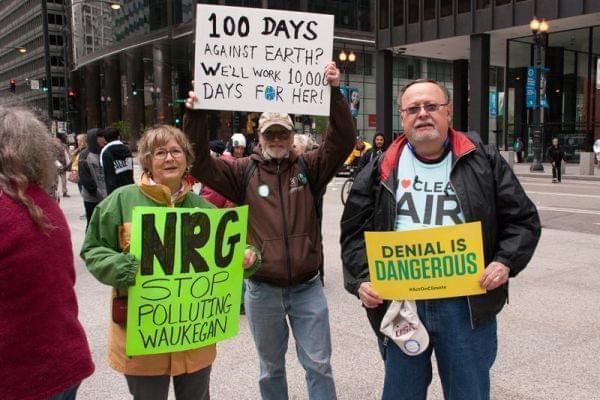
Protesters display signs at an April climate rally. Dylan Blake
For Dulce Ortiz, the Clean Power Plan was a long-awaited victory.
For years, Ortiz and fellow environmental activists had been trying to get rid of the coal-fired power plant in their hometown of Waukegan. Yet pleas to the energy company, to Waukegan’s mayor, and to Illinois energy regulators had all proven unsuccessful.
Then, in August of 2015, former President Barack Obama’s administration unveiled its Clean Power Plan (CPP), which required every state to significantly reduce emissions from power plants by the year 2030. Ortiz and fellow activists believed that the CPP would help force the Waukegan plant to close. “We thought it was finally going to happen,” she says. “But the excitement didn’t last that long.”

Dulce Ortiz is an environmental activist from Waukegan.
Six months later, the U.S. Supreme Court issued a stay on the CPP, halting enforcement across the country. President Donald Trump in March signed an executive order initiating a review of the entire rule.
These setbacks to the CPP have left many wondering about the fate of energy and emissions in Illinois. However, the state still appears on track to meet or exceed the emissions reduction goals assigned to it under the CPP, as lower-carbon energy sources continue to replace coal-fueled plants across the state. Meanwhile, a new state law is expected to bolster this transition to cleaner energy — but also raises some debate about what constitutes ‘clean’ power.
The Waukegan Generating Station, owned by NRG Energy, sits on the Lake Michigan shoreline, just one mile from Ortiz’s home. Three years ago, when Ortiz was diagnosed with asthma (a condition that also affects children in 16 percent of households in Lake County, where the plant is located), she began to suspect that emissions from the plant may have been exacerbating her asthma symptoms.
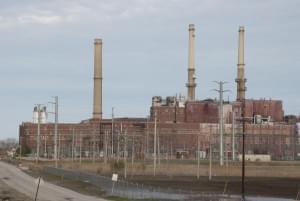
The Waukegan Generating Station
“Recently our air quality was rated an F because of the pollution, and they’re the biggest polluters,” says Ortiz, referring to a report by the NAACP. She and fellow activists had high hopes that the CPP would change that.
Finalized in October of 2015, the CPP targeted greenhouse gas emissions that emanated from power plants, which account for nearly a third of US emissions nationally, according to U.S. Environmental Protection Agency data. Under the CPP, the U.S. EPA would set carbon dioxide emissions reduction targets for each state. “Each state would then have to come up with a plan that it would propose to U.S. EPA for how it would achieve those emission reductions inside of its state, and U.S. EPA would have to bless or reject it,” says Mark Templeton, director of the Abrams Environmental Law Clinic at the University of Chicago Law School.
The state implementation plans would include a combination of three methods: improving the efficiency of coal-burning plants, transitioning coal plants to lower-emitting natural gas fuel, and encouraging the adoption of renewable energy sources like wind and solar. If a state failed to design an adequate plan, the EPA could prescribe one for them.
Under the CPP, Illinois was required to reduce emissions from its power generators approximately 31 percent by 2030, a goal that the U.S. EPA deemed “one of the least stringent” compared to other states.
When the rule was announced in August 2015, organizers in Waukegan held a party at the lakefront, serving cake to mark the occasion. But not everybody in Illinois was celebrating.
The Illinois Coal Association, a trade organization that represents coal producers across the state, had lobbied against the CPP in Washington. President Phil Gonet says he was concerned that the rule could decrease coal production as much as 250 million tons nationwide, while also creating energy shortages that could increase energy prices as much as 27 percent in Illinois.
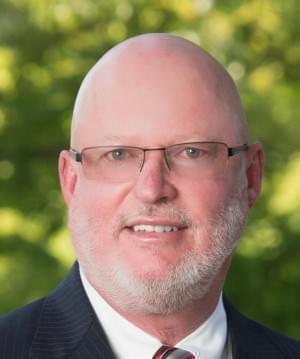
Phillip Gonet is president of the Illinois Coal Association
“I call it the ‘Costly Power Plan,’” says Gonet.
Legal action soon followed. In the fall, a coalition of 26 states, led by West Virginia, filed petitions challenging the CPP in the Washington, D.C. Circuit Court. (Illinois was not among them). The states claimed that the EPA’s authority to regulate greenhouse gas emissions did not apply to existing power plants. In early 2016, they asked the circuit court, and then the U.S. Supreme Court, to halt the CPP until the litigation was complete.
“It kind of went through an unusual process where it got appealed quickly to the Supreme Court, and the Supreme Court put a stay on the implementation of the Clean Power Plan,” explains Templeton. He emphasizes that the stay was a highly unusual action. “I think the Supreme Court was sending a signal that it had very significant concerns.”
The CPP was still stalled over a year later, on March 28, 2017, when President Trump signed an executive order calling for its reevaluation. “Perhaps no single regulation threatens our miners, energy workers, and companies more than this crushing attack on American industry,” Trump told reporters at the signing.
Days later, U.S. EPA Administrator Scott Pruitt sent letters to the governors of several states, including Illinois, informing them that they would not be expected to meet compliance deadlines set forth in the CPP. “The days of coercive federalism are over,” Pruitt wrote.
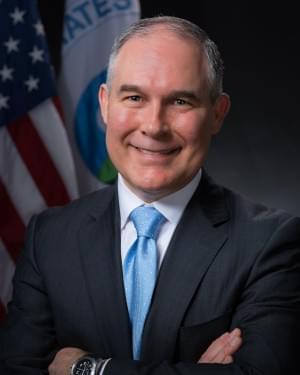
U.S. EPA Administrator Scott Pruitt
However, the views of Trump and Pruitt contrast sharply with those in the Illinois energy sector.
“The CPP wasn’t a cataclysmic event for the industry because most of the industry was already going that way,” says James Monk, president of the Illinois Energy Association, an industry group that represents the major utilities and power suppliers across the state.
Monk says that economic pressures are hurting coal power’s prospects more than the CPP would have. Chief among them: the low price of natural gas, growing consumer demand for clean energy, subsidies for renewable energy and pollution regulations that have made coal plants more expensive to operate.
NRG Energy, which owns the coal-fired plant in Waukegan, acknowledges that coal use is on the decline. Spokesman David Gaier says that in the last two years, the company has converted three large coal-fired plants (including one in Joliet) to natural gas, which emits carbon at about half the rate of coal. “It was a good move economically for NRG and NRG’s shareholders, and it was good for the environment,” he says. “So it was a win-win.”
Last year, the Chicago-based nonprofit Environmental Law and Policy Center calculated the total emissions reductions from coal-fired plants either shuttering or announcing that they would transition to natural gas.
“Within Illinois, we’ve achieved about 80 percent of the carbon pollution reductions that would be required by 2030 under the Clean Power Plan,” says Howard Learner, the organization’s director. “And that’s because there are a number of old coal plants that are highly polluting that simply aren’t making it economically in the power market. They’re being outcompeted by energy efficiency, by wind power, by natural gas and by nuclear power."
In Illinois, many coal plants now exist largely to support intermittent energy sources like wind and solar, which can only create energy under certain conditions, says Monk. “If it is not a sunny day and you’re not getting a lot of solar power, or if it’s not windy day and you’re not getting a lot of power from wind facilities, that power has to come from somewhere. And that’s why you have, in many cases, power plants where their primary role is backup.”
While Illinois’ 15 remaining coal-fired plants still generate roughly a third of the state’s energy, Gaier expects that the trend away from coal will continue in the long term. “Eventually, probably over 30 or 40 years, all coal plants in the country will close,” he says.
For some, though, that is not soon enough.
On a cold and rainy April morning, one month after Trump’s executive order, hundreds of Illinois residents gathered in downtown Chicago for the People’s Climate March. Among them was Dulce Ortiz.
She and 70 fellow activists from Lake County had made the 50-mile trip to join the march, carrying signs that read “NRG Stop Polluting Waukegan” and “#CLEANWAUKEGAN.”
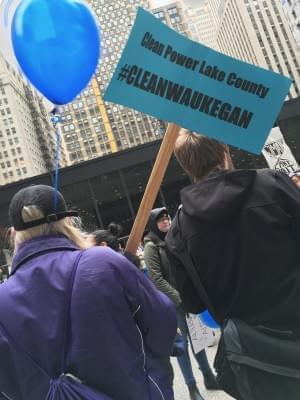
About 70 environmental protesters came to Chicago to march in April.
The Lake County activists expressed frustration at Trump’s hardline stance against the CPP. However, the rule had already been stayed for more than a year before his executive order — and most clean energy advocates had long ago turned their energy elsewhere.
“We couldn’t just rely on the federal level,” says Ortiz. “So that’s actually when we thought, ‘We need to do something on local level.’ And that’s how we started getting involved with the Future Energy Jobs Act.”
The bill that would become the Future Energy Jobs Act (FEJA) was introduced to the state legislature in February 2016. A wide-ranging piece of legislation with major implications for Illinois utility providers, energy companies, and low-income communities, the final Act was approved by the legislature and signed by Governor Rauner in December of 2016, following months of negotiation.
The FEJA requires the state’s major electricity suppliers, ComEd and Ameren, to make efficiency investments to reduce customers’ energy consumption 21.5 percent and 16 percent, respectively, by 2030. It also closes a loophole in an existing law mandating that 25 percent of power statewide come from renewable energy by 2030.
Furthermore, the bill has multiple provisions targeted to low-income areas like Waukegan. It directs $25 million per year toward improving energy efficiency for low-income households, and establishes a fund to help develop solar power in low-income communities.
Environmental justice advocates consider the FEJA a triumph, touting its clean power benefits, job creation opportunities, and health benefits. (The Natural Resources Defense Council estimates that the bill could prevent as many as 17,890 asthma attacks and 2,800 premature deaths between 2018 and 2030).
“We worked really diligently … to really ensure that when folks are talking about clean jobs, that that wasn’t just a number that was thrown out there, but really ensuring these jobs are first and foremost for low-income communities of color,” says Kimberly Wasserman, executive director of the Little Village Environmental Justice Organization, which advised on the bill. “That’s the first time that we’ve seen that level of detail go into a policy in Springfield around environment.”
The FEJA takes a different approach to emissions reduction than the CPP, explains law professor Templeton. While the CPP established environmental statutes that would trickle down to the energy sector, “the Future Energy Jobs Act really comes at it from the other side, the energy side, which will then have impacts on the climate and the environment,” he says.
The bill’s most controversial provision is its “zero-emission credits,” which grant more than $200 million per year to Exelon Corporation for the two nuclear plants it operates in Illinois. A coalition of Exelon’s top energy competitors, including NRG Energy and Dynegy, have filed a lawsuit in district court claiming that these credits amount to an unfair nuclear energy bail-out. An Exelon spokesman defended the provision in an email, stating that the objections "have little to do with protecting consumers and everything to do with protecting their profits."
Environmental justice advocates also took issue with the provision, arguing that while nuclear energy generation does not emit carbon dioxide, it nonetheless cannot be deemed ‘clean’ on account of the toxic waste it produces.
“The attempt to somehow treat nuclear power as equivalent in greenness to energy efficiency, solar power and wind power, is simply wrong,” Environmental Law and Policy Center director Learner told the Chicago Tribune in 2015, when the nuclear subsidy bill was first announced. In the end, Learner's organization supported the bill's renewable energy provisions but took a neutral stance toward the overall bill.
Dulce Ortiz says the zero-emission credits were presented to her as an ultimatum: Either subsidize nuclear energy — or allow coal-fired plants to continue unchecked. “And it was a very difficult decision,” she admits. “I can honestly say I couldn’t sleep for a couple days. Because you don’t want to make that choice, right? The lesser of two evils — they’re both evil.”
In the end, however, Ortiz fully endorsed the FEJA, nuclear subsidies and all. “If that means that a lot more coal plants are gonna be closed, it’s a hit that we had to take,” she says.
For Ortiz, transitioning the Waukegan plant away from coal remains a central goal — one that she once again believes is within reach.
“I’m very optimistic,” she says. “Because coal’s not profitable anymore.”
Illinois Issues is in-depth reporting and analysis that takes you beyond the headlines to provide a deeper understanding of our state. Illinois Issues is produced by NPR Illinois in Springfield.
Links
- Illinois Issues: Fiscal Fantasy
- Illinois Issues: Legislative Checklist
- Illinois Issues: How Republican Efforts To Toss Out Obamacare Might Affect This State
- Illinois Issues: The Trouble With Temp Work
- Illinois Issues: LGBT In The Time Of Trump
- Illinois Issues: The Case For Partial Legalization
- Illinois Issues: This State’s Abortion Debate
- Illinois Issues: Legislative Checklist
- Gov. Rauner Signs Bill Providing Subsidies To Exelon
- Last-Minute Exelon Subsidy Plan Goes To Illinois House Floor
- State Rep. Mitchell Pleased Rauner Admistration Weighing In On Exelon Bill
- Exelon/ComEd Offers Compromises In Nuclear Plant Legislation Talks
- Changes To Measure To Help Exelon Plants
- Economic Growth For Clinton Means More Than Keeping A Nuclear Plant Open

